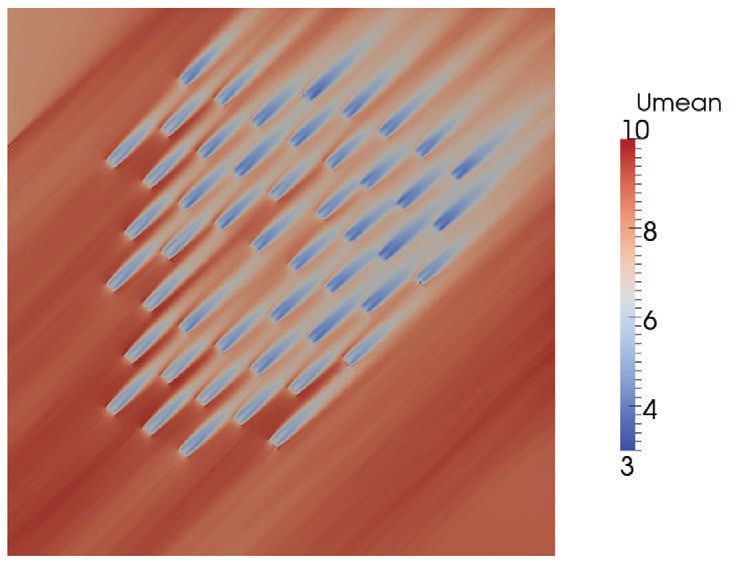Staggered wind turbines
Dr. Neil Canter, Contributing Editor | TLT Tech Beat February 2014
Researchers use a computer program to simulate an offshore wind farm in Sweden.
KEY CONCEPTS
•
A technique known as Simulator for Offshore/Onshore Wind Farm Applications was used to simulate an existing wind farm located offshore in Lillgrund, Sweden.
•
Five hypothetical scenarios of the same wind farm were simulated and evaluated in which the wind farm area was held constant but the number of turbines were significantly reduced.
•
Staggering wind turbines improved the efficiency of each turbine while reducing array losses.
LUBRICATION OF WIND TURBINE GEARBOXES remains a major challenge for the lubricant industry. Premature failures are preventing wind turbines from meeting their original operating life goals of 20 to 30 years. Wind turbines may only operate effectively for half this time period at best.
The gearboxes perform the pivotal function of converting low-speed wind energy captured during rotation of the rotor blades into high-speed energy that can be used to run an electricity producing generator. Reducing stress on this process through having a consistent wind speed and direction is possibly very important in extending the operation of the wind turbine. But wind speed and direction are both quite variable, making it very challenging to achieve this goal.
Despite the problems in predicting wind parameters, aerodynamics has emerged as an important factor in improving the performance and efficiency of wind turbines. If the aerodynamics in a wind turbine farm can be maximized, then this may reduce the stress on the gearboxes.
In a previous TLT article, a study showed how aerodynamics can be used to increase cost-effective power generation in a wind turbine farm (
1). Researchers used a combination of extensive computer simulations and a wind tunnel to develop a model for how close wind turbines should be placed in proximity to each other.
The atmospheric boundary layer, which is typically 500 meters to 1.5 kilometers above the earth’s surface, plays an important role in determining how to position wind turbines in a farm. Research developed from this study suggests that the distance between wind turbines should be doubled from approximately 7.5 to 15 rotor diameters apart.
Cristina Archer, associate professor of physical ocean science and engineering and geography at the University of Delaware in Newark, Del., agrees that positioning of the wind turbines in a farm can influence power production. She says, “There are a number of different variables that must be taken into consideration, including the number of turbines, turbine model and diameter, orientation of the rows based on the main wind direction, size of the wind farm and spacing and alignment of the wind turbines.”
Offshore wind farms can be particularly difficult to assess because of the many variables involved and the relatively small pool of available data. Fortunately, Archer and her research team have now used computer intensive simulations to gain a better understanding of how wind turbines should be spaced in one particular offshore wind farm.
Archer and her research team used a computer program known as Simulator for Offshore/Onshore Wind Farm Applications (SOWFA) to simulate an existing wind farm located offshore in Lillgrund, Sweden. She says, “We set up a series of experiments to simulate how the wind turbine efficiency changes once we adjust one variable at a time. The control for this study is a current wind turbine farm located off the coast of Sweden.”
This particular wind turbine farm was chosen for this study because the prevailing winds originate from the southwest, which is also the prevailing wind direction seen along the East Coast of the U.S. during the summer, according to Archer. There are 48 turbines located in the Lillgrund wind farm.
Archer says, “The current wind farm is laid out in a grid fashion with each turbine spaced 3.2 times the rotor diameter apart across and 4.3 times the rotor diameter along the prevailing wind direction. No wind turbines are placed in staggered positions relative to each other.” In addition, not all rows and columns have the same number of turbines.
The SOWFA utilize sophisticated and computer intensive numerical codes that generate large-eddy simulations of the unsteady, turbulent air motions. Archer says, “We chose to work with SOWFA because it is available from the National Renewable Energy Laboratory. This is a very sophisticated code that requires a great deal of high-performance computer time.”
The researchers prepared simulations of five scenarios, in addition to the control case, where wind turbines are staggered in every second row downwind, double-spaced along the prevailing wind direction, double-spaced across the prevailing wind direction, double-spaced along and across the prevailing wind direction and staggered every second row downwind.
In the simulations, the wind farm area was held constant, which meant that the number of wind turbines used varied in each scenario. For one scenario, the wind farm contained only 12 turbines. In another, the number of turbines was the same as in the control case, but they were staggered.
One parameter included in the study is the wind turbine wake, which is the region downwind of a specific turbine. Figure 2 shows simulations for horizontal cross-sections of instantaneous wind speed obtained 90 meters above the ground for wakes simulated from a staggered wind turbine configuration.
 Figure 2. Simulated wakes generated by wind turbines arrayed in a hypothetical pattern helped to show that better efficiency can be achieved through proper positioning of wind turbines within a specific farm area. (Courtesy of the University of Delaware)
Figure 2. Simulated wakes generated by wind turbines arrayed in a hypothetical pattern helped to show that better efficiency can be achieved through proper positioning of wind turbines within a specific farm area. (Courtesy of the University of Delaware)
The researchers found that there is a non-linear correlation between the number of turbines and the total array output. Archer says, “Output for a wind turbine farm can be evaluated based on the average power per turbine or on the overall power generated. We found that by staggering the wind turbines, the efficiency of each turbine increases while the array losses are reduced.”
For example, the 48 turbines operating in the current Lillgrund wind farm produce electricity at a rate of 33.4 megawatts (MW). In a scenario where the turbines were separated by double-spacing, both along and across the prevailing wind direction and reduced to 12, the production of electricity was expected to be one quarter of 33.4 MW or 8.3 MW, but the simulation indicated that production will reach a much higher rate of 10.6 MW.
Archer says, “Our work suggests that there may not be a need to fill up the entire area of a wind farm with turbines. The Swiss Cheese approach, where there are holes in the wind farm, may prove to be a good strategy for maximizing wind turbine efficiency.”
Future work will determine how to maximize the Lillgrund array in the case of other wind directions, including a northwest wind, which is prevalent during the winter along the East Coast of the U.S. Additional information can be found in a recent reference (
2) or by contacting Archer at
carcher@udel.edu.
REFERENCES
1.
Canter, N. (2011), “Wind Farm Aerodynamics,” TLT,
67 (5), pp. 12-13.
2.
Archer, C., Mirzaeisefat, S. and Lee, S. (2013), “Quantifying the Sensitivity of Wind Farm Performance to Array Layout Options using Large-Eddy Simulation,”
Geophysical Research Letters,
48 (18), pp. 4963-4970.
 Neil Canter heads his own consulting company, Chemical Solutions, in Willow Grove, Pa. Ideas for Tech Beat items can be sent to him at neilcanter@comcast.net
Neil Canter heads his own consulting company, Chemical Solutions, in Willow Grove, Pa. Ideas for Tech Beat items can be sent to him at neilcanter@comcast.net.